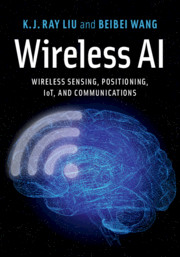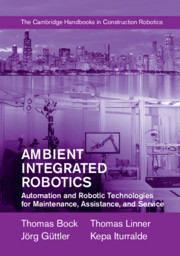Refine listing
Actions for selected content:
1372 results in Ebooks on robotics

Wireless AI
- Wireless Sensing, Positioning, IoT, and Communications
-
- Published online:
- 27 September 2019
- Print publication:
- 03 October 2019

Ambient Integrated Robotics
- Automation and Robotic Technologies for Maintenance, Assistance, and Service
-
- Published online:
- 09 July 2019
- Print publication:
- 27 June 2019
2 - Basic Knowledge, Strategies, and Procedures
-
- Book:
- Ambient Integrated Robotics
- Published online:
- 09 July 2019
- Print publication:
- 27 June 2019, pp 12-36
-
- Chapter
- Export citation
4 - Existing AAL Products
-
- Book:
- Ambient Integrated Robotics
- Published online:
- 09 July 2019
- Print publication:
- 27 June 2019, pp 74-103
-
- Chapter
- Export citation
Contents
-
- Book:
- Ambient Integrated Robotics
- Published online:
- 09 July 2019
- Print publication:
- 27 June 2019, pp v-vii
-
- Chapter
- Export citation
Acknowledgments
-
- Book:
- Ambient Integrated Robotics
- Published online:
- 09 July 2019
- Print publication:
- 27 June 2019, pp viii-x
-
- Chapter
- Export citation
6 - Future Trends and Developments
-
- Book:
- Ambient Integrated Robotics
- Published online:
- 09 July 2019
- Print publication:
- 27 June 2019, pp 140-147
-
- Chapter
- Export citation
1 - Introduction
-
- Book:
- Ambient Integrated Robotics
- Published online:
- 09 July 2019
- Print publication:
- 27 June 2019, pp 1-11
-
- Chapter
- Export citation
5 - Research and Development Projects for AAL Systems
-
- Book:
- Ambient Integrated Robotics
- Published online:
- 09 July 2019
- Print publication:
- 27 June 2019, pp 104-139
-
- Chapter
- Export citation
References
-
- Book:
- Ambient Integrated Robotics
- Published online:
- 09 July 2019
- Print publication:
- 27 June 2019, pp 148-158
-
- Chapter
- Export citation
Copyright page
-
- Book:
- Ambient Integrated Robotics
- Published online:
- 09 July 2019
- Print publication:
- 27 June 2019, pp iv-iv
-
- Chapter
- Export citation
Index
-
- Book:
- Ambient Integrated Robotics
- Published online:
- 09 July 2019
- Print publication:
- 27 June 2019, pp 159-164
-
- Chapter
- Export citation
3 - Built Environment Upgrading for AAL (BeuAAL)
-
- Book:
- Ambient Integrated Robotics
- Published online:
- 09 July 2019
- Print publication:
- 27 June 2019, pp 37-73
-
- Chapter
- Export citation
10 - A Simulated Utopia: The Social System of a Virtual Ancient Egypt
- from Part III - Understanding Culture with Games
-
-
- Book:
- Social Interactions in Virtual Worlds
- Published online:
- 15 June 2018
- Print publication:
- 05 July 2018, pp 253-287
-
- Chapter
- Export citation
13 - Profiling in Games: Understanding Behavior from Telemetry
- from Part IV - Techniques for Analyzing Game Data
-
-
- Book:
- Social Interactions in Virtual Worlds
- Published online:
- 15 June 2018
- Print publication:
- 05 July 2018, pp 337-374
-
- Chapter
- Export citation
Copyright page
-
- Book:
- Social Interactions in Virtual Worlds
- Published online:
- 15 June 2018
- Print publication:
- 05 July 2018, pp iv-iv
-
- Chapter
- Export citation
11 - Gaming in Multicultural Classrooms: The Potential of Collaborative Digital Games to Foster Intercultural Interaction
- from Part III - Understanding Culture with Games
-
-
- Book:
- Social Interactions in Virtual Worlds
- Published online:
- 15 June 2018
- Print publication:
- 05 July 2018, pp 288-310
-
- Chapter
- Export citation
9 - Virtual Economic Experiments
- from Part II - Groups: Norms, Leadership, and Virtual Organizations
-
-
- Book:
- Social Interactions in Virtual Worlds
- Published online:
- 15 June 2018
- Print publication:
- 05 July 2018, pp 218-250
-
- Chapter
- Export citation
1 - VERUS: A Multidisciplinary International Behavioral Study of Virtual World Users
- from Part I - Individual Behaviors and Dyadic Relationships
-
-
- Book:
- Social Interactions in Virtual Worlds
- Published online:
- 15 June 2018
- Print publication:
- 05 July 2018, pp 13-42
-
- Chapter
- Export citation
4 - Couples Who Slay Together, Stay Together: Benefits, Challenges, and Relational Quality among Romantic Couples Who Game
- from Part I - Individual Behaviors and Dyadic Relationships
-
-
- Book:
- Social Interactions in Virtual Worlds
- Published online:
- 15 June 2018
- Print publication:
- 05 July 2018, pp 80-100
-
- Chapter
- Export citation
